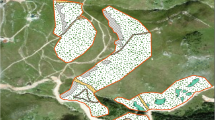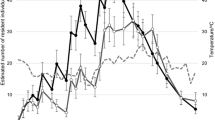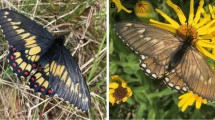Summary
The hilltopping behavior of individuals in a closed demographic unit ofEuphydryas editha is examined. Both males and females hilltop but the behavior differs between the sexes. Most males appear to hilltop throughout their reproductive lives. Females hilltop only as virgins. The occurrence of hilltopping in a population is influenced by the density and age structure of the population. In addition, some males appear not to hilltop, but instead “patrol” below the hilltop, a strategy which may be favored in periods of high density. We suggest that in order to understand the ecological and evolutionary significance of hilltopping, its populational aspects need to be investigated as well as individual behaviors, such as territoriality, which hilltopping butterflies may also exhibit.
Similar content being viewed by others
References
Alcock J (1975) Male mating strategies of some philanthine wasps (Hymenoptera: Sphecidae). J Kans Entomol Soc 45:532–545
Alcock J (1981) Lek territoriality in the tarantula hawk waspHemipepsis ustulata (Hymenoptera: Pompilidae). Behav Ecol Sociobiol 8:309–317
Alcock J (1983a) Consistency in the relative attractiveness of a set of landmark territorial sites to two generations of male tarantula hawk wasps (Hymenoptera: Pompilidae). Anim Behav 31:74–80
Alcock J (1983b) Hilltopping territoriality by males of the great purple hairstreakAtlides halesus (Lepidoptera: Lycaenidae): convergent evolution with a pompilid wasp. Behav Ecol Sociobiol 13:57–62
Alcock J (1984) Convergent evolution in perching and patrolling site preferences of some hilltopping insects of the Sonoran Desert. Southwest Nat 29:475–480
Alcock J (1985a) Hilltopping in the nymphalid butterflyChlosyne californica (Lepidoptera). Am Midl Nat 113:64–75
Alcock J (1985b) Hilltopping behavior in the waspPseudomasaris maculifrons (Fox) (Hymenoptera: Masaridae). J Kans Entomol Soc 58:162–166
Alcock J, Pyle DW (1979) The complex courtship behavior ofPhysiphora demandata (F.) (Diptera: Otitidae). Z Tierpsychol 49:352–362
Alcock J, Schaeffer JE (1983) Hilltop territoriality in a Sonoran Desert bot fly (Diptera: Cuterebridae). Anim Behav 31:518–525
Alcock J, Jones CE, Buchmann SL (1977) Male mating strategies in the beeCentris pallida Fox (Anthophoridae: Hymenoptera). Am Nat 111:145–155
Baker RR (1972) Territorial behavior of the nymphalid butterflies,Aglais urticae (L.) andInachis io (L.). J Anim Ecol 41:453–469
Baker RR (1983) Insect territoriality. Annu Rev Entomol 28:65–89
Baughman JF, Murphy DD, Ehrlich PR (1988) Emergence patterns in male checkerspot butterflies: testing theory in the field. Theor Pop Biol (in press)
Brussard PF, Ehrilich PR, Singer MC (1974) Adult movements and population structure inEuphydryas editha. Evolution 28:408–415
Catts EP (1979) Hilltop aggregation and mating behavior byGasterophilus intestinalis (Diptera: Gasterophilidae). J Med Entomol 16:461–464
Cazier MA, Linsley EG (1963) Territorial behavior among males ofProtoxaea gloriosa (Fox) (Hymenoptera: Andrenidae). Can Entomol 95:547–556
Courtney SP, Anderson K (1986) Behaviour around encounter sites. Behav Ecol Sociobiol 19:241–248
Davies NB (1978) Territorial defense in the speckled wood butterfly (Pararge aegeria), the resident always wins. Anim Behav 26:138–147
Ehrlich PR (1965) The population biology of the butterfly,Euphydryas editha. II. The structure of the Jasper Ridge colony. Evolution 19:327–336
Ehrilich PR, Murphy DD (1987) Conservation lessons from longterm studies of checkerspot butterflies. Cons Biol 1:122–133
Ehrlich PR, Wheye D (1984) Some observations on spatial distribution in a montane population ofEuphydryas editha. J Res Lepid 23:143–152
Ehrlich PR, Wheye D (1986) “Non-adaptive” hilltopping behavior in male checkerspot butterflies (Euphydryas editha). Am Nat 127:477–483
Ehrlich PR, White RR, Singer MC, McKechnie SW, Gilbert LE (1975) Checkerspot butterflies: a historical perspective. Science 188:221–228
Ehrlich PR, Launer AE, Murphy DD (1984) Can sex ratio be determined? The case of a population of checkerspot butterflies. Am Nat 123:527–539
Fitzpatrick SM, Wellington WG (1983) Insect territoriality. Can J Zool 61:471–486
Iwasa Y, Odendaal FJ, Murphy DD, Ehrlich PR, Launer AE (1983) Emergence patterns in male butterflies: A hypothesis and a test. Theor Pop Biol 23:363–379
Lederhouse RC (1982) Territorial defense and lek behavior of the black swallotail butterfly,Papilio polyxenes. Behav Ecol Sociobiol 10:109–118
Matthes-Sears W, Alcock J (1986) Hilltopping behavior ofPolistes navajoe (Hymenoptera: Vespidae). Ethology 71:42–53
Murphy DD (1984) Butterflies and their nectar plants: The role of the checkerspot butterflyEuphydryas editha as a pollen vector. Oikos 43:113–117
Murphy DD, Menninger MS, Ehrlich PR, Wilcox BA (1986) Local population dynamics of adult butterflies and the conservation status of two closely related species. Biol Cons 37:201–223
Odendaal FJ, Iwasa Y, Ehrlich PR (1985) Duration of female availability and its effect on butterfly mating systems. Am Nat 125:673–678
Otronen M (1984) The effect of differences in body size on the male territorial system of the flyDryomyza anilis. Anim Behav 32:882–890
Partridge L, Farquhar M (1983) Lifetime mating success of male fruitflies (Drosophila melanogaster) is related to their size. Anim Behav 31:871–877
Scott JA (1968) Hilltopping as a mating mechanism to aid the survival of low density species. J Res Lepid 7:191–204
Scott JA (1974a) Mate locating behavior of butterfliers Am Midl Nat 91:103–117
Scott JA (1974b) Adult behavior and population biology ofPolyadras minuta, and the relationship of the Texas and Colorado populations. Pan-Pacific Entomol 50:9–22
Shields O (1967) Hilltopping. J Res Lepid 6:69–178
Shreeve TG (1984) Habitat selection, mate location and microclimate constraints on the activity of the speckled wood butterflyParargae aegeria. Oikos 42:371–377
Singer MC (1972) Complex components of habitat suitability within a butterfly colony. Science 173:75–77
Thornhill R, Alcock J (1983) The evolution of insect mating systems. Harvard University Press, Cambridge, Mass
Wickman P (1985) Territorial defence and mating success in males of the small heath butterfly,Coenonympha pamphilus L. (Lepidoptera: Satyridae). Anim Behav 33:1162–1168
Wickman P, Wiklung C (1983) Territorial defence and its seasonal decline in the wood butterfly (Pararge aegeria). Anim Behav 31:1206–1216
Author information
Authors and Affiliations
Rights and permissions
About this article
Cite this article
Baughman, J.F., Murphy, D.D. & Ehrlich, P.R. Population structure of a hilltopping butterfly. Oecologia 75, 593–600 (1988). https://doi.org/10.1007/BF00776425
Received:
Issue Date:
DOI: https://doi.org/10.1007/BF00776425




